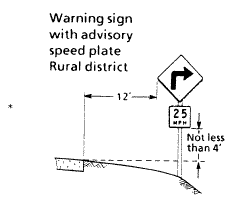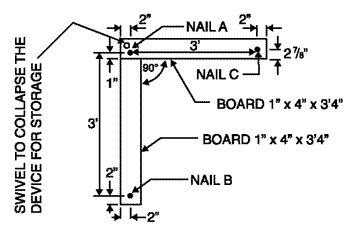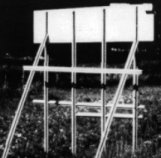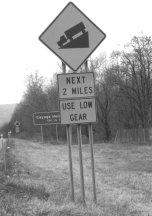Location and Height of Signs
The location of signs is usually established by the guidance set forth in the current edition of the "Manual on Uniform Traffic Control Devices," State standards and/or directives, and legal procedures and/or requirements.
A sign may require replacement, an additional sign may be added or a whole sign assembly (sign(s) and support) may require replacement. Do not rely on original position and height of the sign as appropriate criteria. It is important to check the location of the support and the mounting height of the sign above the roadway to ensure the sign is legible and crashworthy. Additionally, it is essential to locate small sign supports (crashworthy sign supports) so they function properly, and remember, check new sign locations to ensure there are no utility problems or sight obstructions. Before changing the location of a support or the height of a sign, check with your supervisor.
The figures below represent the recommended height and location as provided in the MUTCD.




* A height of 7' or more from the bottom of the sign to the ground is recommended in all areas where there are bus stops, pedestrians or bicycle traffic.
Positioning Signs
To obtain maximum reflection from traffic signs, yet eliminate specular glare, signs should be correctly aligned. Specular glare is the mirror type reflection characteristic of any glossy surface. Under severe circumstances, such as direct sunlight, specular glare can make the sign legend unreadable. Often this becomes apparent from driver complaints.
- On straight sections of highway, sign should be positioned slightly away from the driver. The recommended angle, as shown below, is 93 degrees.

- On curved sections of highway, the sign should be positioned at an angle of 93 degrees away from the driver at the point where the sign is to be read.

- On existing sign supports, signs can be shimmed or reattached to reduce reflective glare.
To obtain a 93-degree angle for roadside signs, the device described below can be fabricated and used.

TO USE THIS DEVICE:
Position on the ground so that a line from Nail A to Nail B is parallel to the driver's line of sight (either straight along the roadway or where the driver should first see the sign). A string or straight edge can then be placed from nails A to C to establish the appropriate sign position.

Sign Turners

- Pipe handle about four feet long.
Shown here is a locally fabricated tool for aligning the sign and post before final tamping. A metal U-shape the size of the wood post (4"X 4" or 4"X 6") has a pipe handle welded to it. After attaching the sign to the post, filling the hole, and lightly tamping the material, one person checks the sign to make certain it is facing the roadway at the proper angle to be seen at night while the other person rotates the post with the tool.
- 1 Pc. - 1 1/2" Black Pipe - 50" long
- 1 Pc. - 5/8" x 3" x 10" long
- 1 Pc. - 3/4" x 3/4" x 5/8" long
- 1 Pc. - 1/4" x 3/4" x 20" long
- 1 Pc. - 3/8" x 3/8" x 3" long
- 1 - Clevis slip hook (remove eye)
Crashworthy Sign Supports
Wood Post
 * For rural areas, the minimum height from bottom of sign may be 5'. |
Small supports. Cross section is 16 sq. inches. Posts should be buried in firm ground. Minimum recommended depth is three feet. You may need to bury deeper to reduce vandalism. Do not encase post in concrete. One or two posts may be used. Large Supports should be drilled. A 6" X 8" wood post can be used if the cross section is weakened by drilling two 3-inch holes as shown in the lower drawing (drill perpendicular to roadway). A 4" X 4" is the largest undrilled wood post recommended to act as a breakaway support. Maximum Post SizesMax. Sign Panel Post Size 18" X 24" 4" X 4" nom. 30" X 30" 4" X 6" nom.(2" holes) 36" X 48" 6" X 6" nom.(2" holes) Sign Panels. Sign panels should be bolted to the post with oversized washers. This will prevent the panel from separating from the post on impact and then penetrating a windshield. Set the bottom of the sign panel a minimum of 7 feet above the pavement or ground. This will limit the chance of the sign and post rotating and hitting the car's windshield. |
U-Channel Steel Post
The U-channel, hot rolled steel post is the second most common small sign support. It is considered breakaway since it will bend, break or pull out of the ground when it is hit.
 * One post at each end of sign; not a single post made of two rails bolted together |
Post Support. The post should be driven into the ground and not encased in concrete. Drive posts into the ground no more than 3.5 feet to make it easier to pull out damaged posts. Breakaway Devices. Splices can be purchased commercially to install at ground level (see lower drawing). They allow the post to break off on impact. These devices improve safety when the post is hit, will make repair easier, and will make it possible to use a U-channel post when it has to be placed in a concrete area. An alternate installation is to set a stub post in the concrete with a 4-inch length available to bolt to the sign post as a base connection. Maximum Post Size Max. Size Panel Post Size 18" X 24" 2 lb/ft 30" X 30" 3 lb/ft 36" X 48" 2 @ 2 lb/ft* Sign Panels. Sign panels should be securely bolted to the post with oversized washers. This will prevent the panel from separating from the post on impact and then penetrating a windshield. Set the bottom of the sign panel a minimum of 7 feet above the pavement or ground. This limits the chance of the sign hitting a car's windshield. |
Square Steel Tube
Another sign post is the square steel tube (perforated) design. It is used in many localities.
 |
Post Support. Posts can be driven into the ground. Do not place concrete around the post. A broken or damaged post is easier to remove if it is not driven or set into the ground more than three feet. Breakaway Devices. Sleeve assemblies like the one shown in the lower drawing will increase the safety of a sign when it is hit and make it easier to repair. After the sign has been hit, the broken stub of the post can be removed from the base sleeve and a new sign post put back in place. Maximum Post Size Max. Sign Panel Post Size 30 " X 30" 2.25" X 2.25" X 0.105" Sign Panels. Attach the sign panels tightly to the post and use oversized washers to keep the sign from breaking loose from the post when a vehicle hits it. Sign panels should be mounted a minimum of 7 feet above the pavement or ground. |
There are many other products available commercially for sign supports. Use depends on local requirements and costs. This publication only shows four of the most common types of small sign supports.
Slip Bases
When installing, replacing or repairing sign support systems always follow the manufacturer's instructions to ensure proper performance.

In this case, the slip base supports are under several inches of back fill, consequently failed to activate when hit, note the bending of the left leg.
Typical torque requirements for slip base breakaway systems.
| Post Size Pounds per Foot |
Slip Base Bolt Diameter (in) |
Clamping Force (pounds) |
Bolt Torque (inch-pounds) |
Max Torque (ft-pounds) |
|---|---|---|---|---|
| 1 - 8 | 1/2 | 920 - 1380 | 95 - 142 | 12 |
| 9 - 20 | 5/8 | 1740 - 2660 | 226 - 345 | 29 |
| 21 - 30 | 3/4 | 2400 - 3600 | 369 - 554 | 46 |
| 30 + | 1 | 2400 - 3600 | 460 - 735 | 60 |
Unsafe Practices
Some practices or efforts to improve maintenance can reduce the positive safety aspects of crashworthy sign and sign support designs. The following examples will give you an idea of the kind of things to watch out for. Look carefully around your own areas of responsibility to ensure that past efforts have not compromised the crashworthiness of the design or situation.
 |
This sign has multiple posts supporting it when two are probably enough. Also, two horizontal braces cross the bottom. These increase the strength of the support greatly, but a small car hitting this is likely to stop suddenly, causing a severe accident. Larger posts with breakaway mechanisms at the ground are better. |
The environment can also be a factor on the safety characteristics of sign supports. The two most common conditions that can affect the crashworthiness of a sign support are erosion of soil at the base and the growth of trees around the support.
 |
Use of too many supports, either on one sign or for a group of signs can produce a hazard. This supporting system is too rigid and may contribute to overturning, loss of control or abrupt stopping. |
 |
While the system used is a breakaway base the pedestal it is mounted on was either not back filled around or the soil has eroded around it. This support system is now a hazard as it constitutes a rigid concrete block more than four inches above the surrounding ground. This can snag the under-carriage of a vehicle causing it to stop abruptly or go out of control. |

